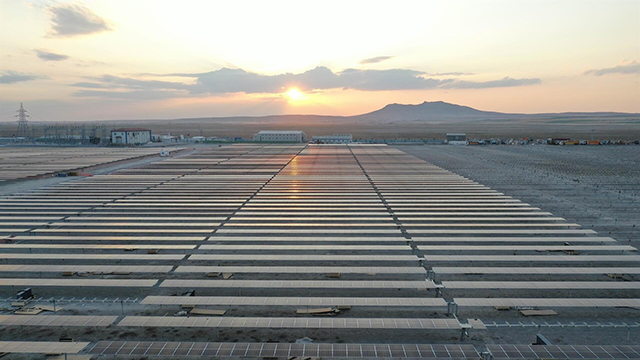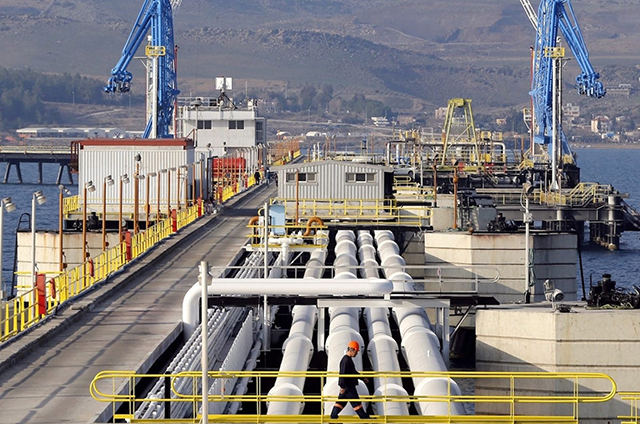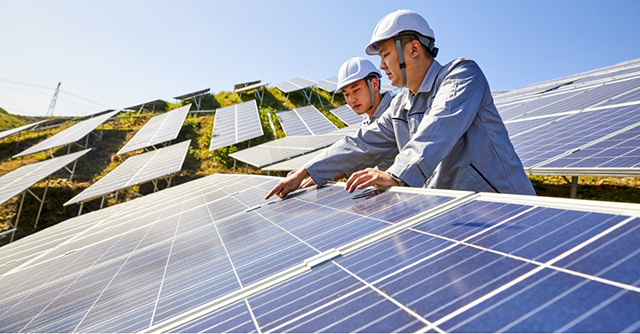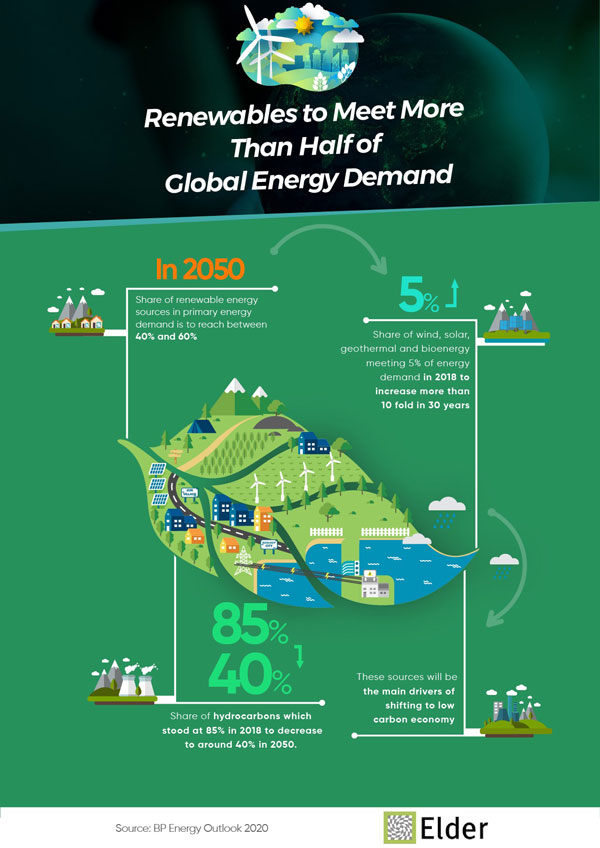
The Karapınar Solar Energy Plant, being built on a 20-million-square-meter land in the Central Anatolian province of Konya, has started generating power nearly three years ahead of its completion, according to a company official.
“We will complete the construction of this facility in 32 months. Solar panels with a capacity of 1,300 megawatts will be established. The works will be completed by May or June 2023. We will generate 2.6 million kilowatt-hours [kWh] of power annually when it’s completed,” said Kalyon Holding Energy Group executive Murtaza Ata yesterday.
“We’re at the largest solar power plant built by an investor on a single parcel of land in the world. This is a sunlight valley,” Ata told Demiroren News Agency.
So far, 10,200 of the planned 3.5 million solar panels have been installed in the field, according to Ata, who also said that 4 MW of power is being transferred to the national grid after Energy and Natural Resources Ministry officials gave the final approvals last weekend. The amount of power generated will increase gradually as the construction gathers pace with the installation of 104,000 solar panels in a month, he added.
The solar panels have a domestic production rate of 75 percent. Turkey opened its first integrated solar panel facility in Ankara’s Baskent Organized Industrial Zone in a high-profile ceremony on Aug. 19. The $400-million Solar Technologies Factory was also built by Turkish energy and construction giant Kalyon Holding. The factory, which will manufacture ingot, wafer, module and cell units with a capacity of 500 MW per year, will subtract $100 from the country’s yearly solar panel import bill.
The $1 billion Karapınar solar energy facility was constructed by Kalyon Holding in collaboration with China Electronics Technology Group Corporation (CETC).
When completed, the facility will increase solar energy’s share in energy generation 25 percent, according to the data from the energy ministry.
Turkey’s total electricity production was approximately 27,462 million kWh in July, according to the Energy Market Regulatory Authority (EPDK). In July, Turkey produced its electricity from several sources; 25.2 percent from hydropower, 24.1 percent from natural gas, 21.9 percent from import coal, and 12.4 percent from lignite. Wind, geothermal, biomass, hard coal, asphaltite, solar power and fuel oil generated the remaining share. Karapinar solar energy facility is being constructed on a land that was a lake until recent years.
“Local people used to catch fish some 30 years ago. In the last 30 years, the evaporation rate has been recorded as three times higher than the precipitation rate as a result of climate change. Ironically, we are trying to stop climate change by building solar panels on a land of a lakebed that dried up because humanity has been using fossil fuels in incredibly high amounts,” said Ata.
Nearly 0.1 percent of Turkey’s annual energy needs will be generated in the facility in 2023, providing electricity to around 2.5 million people. It will prevent the consumption of 1.5 million tons of fossil fuels a year.
Source: Hurriyet Daily News

Turkey's energy import bill decreased by 34.5% to $2.14 billion this August compared to the same month last year, according to the national statistical body Wednesday.
The overall energy import bill was down last month, with a fall in the country's crude oil purchases, the Turkish Statistical Institute (TurkStat) said.
The data shows that the country's overall import bill, including energy and other items, totaled $18.74 billion in August, with energy accounting for 11.42% of the overall import figures. The country's crude oil imports also showed a nearly 30% drop compared to August 2019. Turkey imported approximately 1.87 million tons of crude oil last month, down from 3.04 million tons in August 2019.
The country's overall exports dropped 5.7% in August year-on-year to reach $12.5 billion, the data showed. Imports, on the other hand, rose 20.4% to stand at $18.7 billion in the month, versus the same month last year.
The country's foreign trade deficit leaped 168.2% year-on-year in August to $6.278 billion, the statistics institute data showed. In August, the export-to-import coverage ratio came to 66.5%, while it was 85% the same month last year.
Source: Daily Sabah

Renewable energy continues to bring socio-economic benefits by creating numerous jobs worldwide, according to the latest figures released by the International Renewable Energy Agency (IRENA) today.
The seventh edition of Renewable Energy and Jobs – Annual Review shows that jobs in the sector reached 11.5 million globally last year, led by solar PV with some 3.8 million jobs, or a third of the total.
“Adopting renewables creates jobs and boosts local income in both developed and developing energy markets,” said IRENA’a Director-General Francesco La Camera
“While today we see a handful of countries in the lead, each country can harness its renewable potential, take steps to leverage local capabilities for industrial development, and train its workers.
Last year, 63% of all renewables jobs were recorded in Asia confirming the region’s status as a market leader, the new report reveals. Biofuels jobs followed closely behind solar PV, reaching 2.5 million. Many of these jobs are in the agricultural supply chain, particularly in countries like Brazil, Colombia, Malaysia, the Philippines and Thailand, with labour-intensive operations. Other large employers in the renewables sector are the hydropower and wind industries, with close to 2 million and 1.2 million jobs, respectively.
The report highlights that women held 32 per cent of total renewables jobs, as opposed to 21 per cent in fossil fuels sectors. Although precise estimates remain scarce and absolute numbers are small for now, off-grid renewables are creating growing employment, led by solar technology. Decentralised renewable energy can also propel productive uses in rural areas. This job multiplier effect can be seen in farming and food processing, healthcare, communications, and local commerce. Comprehensive policies, led by education and training measures, labour market interventions, and industrial policies that support the leveraging of local capacities, are essential for sustaining the renewables jobs expansion.
The 2020 edition of the Annual Review highlights promising initiatives to support the education and training of workers. Such efforts revolve around vocational training, curricula-building, teacher training, the use of information and communications technology, promotion of innovative public-private partnerships, and recruitment of under-represented groups such as women.
Policymakers must also prioritise reskilling for fossil fuel sector workers who have lost or are at risk of losing their livelihoods.
Many have considerable skills and expertise to contribute to a reoriented, clean energy industry. The world has seen encouraging growth in renewables jobs. But it can bring about much larger employment by adopting a comprehensive policy framework that drives the energy transition. Never has the importance of such a push been clearer than at this momentous juncture. Even as the world is still dealing with the COVID-19 pandemic, humanity receives near-daily reminders of what lies in store if we fail to address the gathering climate disruptions.
The need to chart a different course is undeniable, as are the benefits to be reaped. IRENA’s recently-released Post-COVID Recovery Agenda found that an ambitious stimulus programme could create up to 5.5 million more jobs over the next three years than a business-as-usual approach. Such an initiative would also allow the world to stay on track for creating the 42 million renewables jobs that the agency’s Global Renewables Outlook projects for 2050.

Solar power will be the largest source of power in Europe, in terms of installed capacity, within five years, the head of the International Energy Agency (IEA) revealed on Tuesday morning.
Fatih Birol told SolarPower Europe’s Solar Power Summit: “Our numbers show that if Europe is keen and able to follow a net-zero goal, within five years of time solar will be the number one electricity capacity in Europe, overtaking everybody.”
The IEA executive director said the information is contained within the organisation’s forthcoming World Energy Outlook report, which is due out on 13 October. He provided no further details, other than to point out that governments were increasingly recognising that PV is the cheapest form of new electricity generation in many parts of the world.
SolarPower Europe is expecting that there will be between 180.1GW and 276.8GW of PV installed across the EU-28 (including the UK) by the end of 2023, up from 131.9MW at the start of this year.
By way of comparison, the International Renewable Energy Agency (IRENA) says that 191.4GW of wind and 156.4GW of hydro were installed in the EU-28 at the end of last year, with official EU statistics putting the capacity of nuclear at 107GW and electricity from “combustible fuels” at 404.2GW (without breaking this figure down any further).
Recharge understands that 143.4GW of coal-fired power was in operation in the EU-28 at the end of 2019, but has not been able to provide an installed capacity figure for gas-fired generation.
Of course, capacity is very different to output, with onshore wind producing almost twice as much energy per installed megawatt as solar, and nuclear more than four times as much, due to their respective capacity factors.
Solar generated just over 110GWh of electricity in the EU-27 in 2018, according to the latest official EU figures, compared to 227.4GWh from wind, 389.6GWh from hydro, 491.5GWh from natural gas, and 595.6GWh from coal
Source: Recharge News

German Chancellor Angela Merkel has thrown her weight behind the European Commission’s proposal to increase the bloc’s climate target to a 55 percent greenhouse gas reduction by 2030. Speaking in federal parliament, she said the country's current EU Council presidency would work towards achieving a unanimous decision by all EU member states by the end of the year.
Chancellor Angela Merkel said the German presidency of the EU Council would "fight" to make member states agree a greenhouse gas reduction target of 55 percent, as proposed by the European Commission, describing climate action as the “large task for the future that we must put at the forefront.” Speaking in the German parliament during a federal budget debate, she added: “By the end of the presidency, our aim is to have a unanimous decision by all member states that we agree on this 55 percent target for the EU.” This has to be achieved by the end of the year to allow for regulatory implementation in 2021, Merkel said.
The European Commission under president Ursula von der Leyen has proposed an increase in the bloc's 2030 greenhouse gas reduction target to “at least 55 percent” (currently 40%), but the decision is far from taken. Member states, some of which have cautioned against too much ambition, still need to agree on their position before a final target is embedded in the planned EU climate law after negotiations with the European Parliament.
Germany has long made finding an agreement on the issue among member states one of the key climate policy objectives of its EU Council presidency in the second half of 2020. However, the government has emphasised its role as a mediator and honest broker during these six months, so throwing its weight behind the Commission's proposal sends a clear message to member states.
Despite the current COVID-19 and economic crisis, Germany’s long-term challenges have not changed, Merkel said. “We can see at every turn that the effects of climate change are becoming increasingly visible,” she added, naming drought, the poor condition of the country’s forests and water scarcity as areas where climate change was already visible in Germany. Talking about international climate policy cooperation, Merkel said: "It's beyond doubt that we have to cooperate with China on climate action and it's good news that China stands by the Paris Agreement in contrast to other emitters.”
While the EU is on track to overshoot its current target of reducing emissions by 40 percent, raising it to 55 percent would require significant additional efforts by the member states. Talks on the exact target which the German Council presidency aims to facilitate could become quite a challenge.
Some eastern European countries, which rely on traditional polluting industries and face a hard time dealing with the economic and social transition necessary in order to become climate neutral, have been especially sceptical. Others have recently criticised the proposal for including emissions from the land use and forest sector, which is likely to take pressure off other areas, as the sector today net-absorbs more emissions EU-wide than in 1990. Heads of state and government meet in Brussels 15-16 October and will likely debate the target – as will environment ministers a week later on 23 October during their next formal meeting.
Source: Clean Energy Wire

Shell, which had 83,000 employees at the end of 2019, said that the reorganisation will lead to additional annual savings of around $2 billion to $2.5 billion by 2022, going partly beyond cuts of $3 to $4 billion announced earlier this year.
Shell's London-traded shares were up 0.15% by 0920 GMT, compared with 0.9% gains for the broader energy sector
Last month it launched a broad review of its business aimed at cutting costs as it prepares to restructure its operations as part of the shift to low-carbon energy.
The Anglo-Dutch company said it expected to cut 7,000 to 9,000 jobs by the end of 2022, including some 1,500 people who have agreed to take voluntary redundancy this year.
Rival BP BP this year announced plans to cut around 10,000 jobs as part of CEO Bernard Looney's plans to rapidly expand its renewables business and reduce oil and gas production.
Reducing costs is vital for Shell’s plans to move into the power sector and renewables where margins are relatively low.
Competition is also likely to intensify with utilities and rival oil firms including BP and Total all battling for market share as economies around the world go green.
“We have looked closely at how we are organised and we feel that, in many places, we have too many layers in the company,” CEO Ben van Beurden said in an internal interview published on Shell’s website.
Source: Reuters
Innovation in Batteries and Electricity Storage
This joint study by the International Energy Agency and European Patent Office underlines the key role that battery innovation is playing in the transition to clean energy technologies. It provides global data and analysis based on the international patent families filed in the field of electricity storage since 2000 (over 65 000 in total).
Please click here to read the full report.
ETS Evolution and Its Impact on Fuel Switching
07 October 2020
World Energy Week
07 - 09 October 2020
Deploying Secure & Flexible Energy Storage - Challenges and Opportunities
14 October 2020
Role of Energy Efficiency in Turkey’s Energy Transition
13 October 2020
World Energy Outlook Launch
13 October 2020
4th International Congress on Economics, Finance & Energy (EFE’2020)
14 - 15 October 2020
ICCI 2020
14 - 16 October 2020
6th International Congress on Energy Efficiency and Energy Related Materials
14 - 20 October 2020

